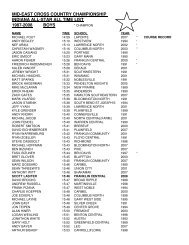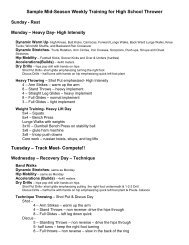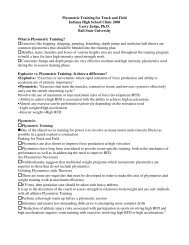glide shot put drills and throwing progressions - iatccc
glide shot put drills and throwing progressions - iatccc
glide shot put drills and throwing progressions - iatccc
Create successful ePaper yourself
Turn your PDF publications into a flip-book with our unique Google optimized e-Paper software.
GLIDE SHOT PUT DRILLS AND<br />
THROWING PROGRESSIONS<br />
BY JOHN SMITH<br />
SOUTHERN ILLINOIS<br />
UNIVERSITY
Drill #1 Non-Reverse St<strong>and</strong>ing Throw<br />
Followed By a Reverse St<strong>and</strong>ing Throw<br />
1.) Feet are placed shoulder width with the left toe splitting the middle of the right foot.<br />
2.) Thrower transfers 80% of bodyweight onto the ball of the right foot, with the torso rigid<br />
<strong>and</strong> hips under the thrower. Right toe should be pointing towards the 11.00 o’clock<br />
position in the ring with the back of the ring being 12.00 o’clock. (Show a big right leg)<br />
3.) Shot <strong>put</strong> should be about 1 foot behind the throwers right foot if the <strong>shot</strong> was dropped<br />
in the power position. Eyes are level in this position <strong>and</strong> not looking at the ground.<br />
(Do not bend at the waist this is a weak position)<br />
4.) Thrower starts to LIFT <strong>and</strong> TURN the ball of the right foot, knee, hip while the left leg<br />
stays fairly stiff <strong>and</strong> slightly turns in the direction of the throw.<br />
5.) As the body starts to lift <strong>and</strong> rotate towards the field the <strong>put</strong>ting action starts to take<br />
place. The left arm leads upward, long <strong>and</strong> around as the <strong>shot</strong> is pushed forward off<br />
the neck with the fingers pointing towards the throwers face <strong>and</strong> the elbow behind the<br />
throw.<br />
6.) The ball is struck with full upward extension of the legs, while the left side is stopped<br />
<strong>and</strong> blocked as the right side finishes the throw.( A good non-reverse st<strong>and</strong>ing throw<br />
is one when the thrower delivers the <strong>shot</strong> <strong>and</strong> watches the <strong>shot</strong> hit the ground)<br />
7.) The reversed throw is the same as the non- reversed throw except the right leg will<br />
replace the left leg at the front on the ring at the end of the throw.
Drill #2 Non-Reverse Pull-Unders<br />
Followed by a Reverse Pull-Under<br />
1.) The right foot starts in the back of the ring(12.00 o’clock position)<br />
while the left heal is reached back as far as possible towards the<br />
direction of the throw. (Split position)<br />
2.) Upper body is facing the back of the circle until the leg is pulled to<br />
the st<strong>and</strong>ing throw position.<br />
3.) When the right foot arrives to the middle of the circle at the 11.00<br />
o’clock position it quickly lifts <strong>and</strong> turns into a non-reverse throw as<br />
the left arm leads towards the field during this lifting <strong>and</strong> turning<br />
action of the right side.<br />
4.) This drill teaches a thrower how to pull the right foot to the correct<br />
spot <strong>and</strong> trains the right leg to lift <strong>and</strong> turn into the throw with little<br />
hesitation.<br />
5.) The reversed pull-under is the same as the non-reversed pull-under<br />
throw except the right leg will replace the left leg at the front on the<br />
ring at the end of the throw.
Drill #3 Non-Reverse Straight Leg Glide<br />
Followed by a Reversed Straight Leg Glide<br />
1.) Thrower starts in the back of the ring in normal starting position (right foot at<br />
12.00 o’clock position) shoulders square to the back of the ring.<br />
2.) Thrower will bend <strong>and</strong> use ONLY THE RIGHT LEG while the left leg stays<br />
perfectly straight 6-8 inches above the ground during the <strong>glide</strong>.<br />
3.) When the thrower arrives into the power position the throw is made just like<br />
a normal throw without any aid of movement from the left leg.<br />
4.) This drill trains the right foot, right hip, right shoulder to move in proper order<br />
as the left side learns to open long <strong>and</strong> smooth into a solid left side block.<br />
5.) Thrower should watch the <strong>shot</strong> hit the ground as the right leg stays in<br />
contact with the middle of the ring. This will develop a proper left side block.<br />
(This is the No#1 drill to teach gliding, takes care of 90% of all<br />
problems)<br />
6.)The reversed straight leg <strong>glide</strong> is the same as the non- reversed straight leg<br />
<strong>glide</strong> except the right leg will replace the left leg at the front on the ring at<br />
the end of the throw.
Drill #4 Double Hop Throw<br />
1.) Find at least 12 feet of space to do this drill.<br />
2.) Thrower starts in the normal starting position <strong>and</strong> performs a normal<br />
<strong>glide</strong> without <strong>throwing</strong> the <strong>shot</strong> <strong>and</strong> the left leg still in the air about 6<br />
inches above the ground.<br />
3.) The thrower should l<strong>and</strong> on the right leg after the first hop <strong>and</strong> then<br />
immediately <strong>glide</strong> into a full throw. (If the weight is not over the right<br />
leg, the thrower will not be able to <strong>glide</strong> into the next throw.)<br />
4.) This drill teaches good right to left rhythm <strong>and</strong> proper transfer of<br />
weight into the finish of the throw <strong>and</strong> teaches the thrower to keep<br />
the <strong>shot</strong> back in the middle of the ring while gliding.<br />
5.) This drill also develops plyometric leg strength for the <strong>glide</strong>.<br />
6.) This is the no#2 drill in Glide Shot Putting. It can be done from a<br />
non-reverse throw or a reverse throw. This drill develops good<br />
fluidness of the movement.
Drill #5 Blending into a Full<br />
Competition Throw<br />
1.) Straight leg non-reverse throw followed by a Full reversed throw. (I<br />
like these throws to be reversed <strong>throwing</strong> over a folding table as<br />
your toe board)<br />
OR<br />
2.) A Non-Reverse Full throw followed by a Full reversed throw over a<br />
table or in the ring.<br />
3.) This drill can be performed from a static start or a dynamic start<br />
throw. (Starting from a st<strong>and</strong> still or starting from a walk in dynamic<br />
start throw.)<br />
4.) Reversing is the result of good mechanics. Reversing is a method of<br />
staying in. Non-Reversing is also a method of staying in the ring.<br />
Each thrower has to find what is best for them.
Example- High School Glide Practice<br />
Drill<br />
Throw#1<br />
Throw#2<br />
Throw#3<br />
Throw#4<br />
Throw#5<br />
Throw#6<br />
#1-Non-Reverse<br />
St<strong>and</strong>ing throw<br />
followed by a<br />
Reversed<br />
st<strong>and</strong>ing throw.<br />
Girls- 10lb<br />
Boys-14lb<br />
2 ROUNDS<br />
Girls- 4k<br />
Boys-12lb<br />
2 ROUNDS<br />
Girls- 8lb<br />
Boys-5k<br />
2 ROUNDS<br />
Girls- 3k<br />
Boys-10lb<br />
2 ROUNDS<br />
#2- Non-Reverse<br />
Pull-unders<br />
followed by a<br />
reversed pullunder<br />
Girls- 10lb<br />
Boys-14lb<br />
1 ROUNDS<br />
Girls- 4k<br />
Boys-12lb<br />
1 ROUNDS<br />
Girls- 8lb<br />
Boys-5k<br />
1 ROUNDS<br />
Girls- 3k<br />
Boys-10lb<br />
1 ROUNDS<br />
#3- Non Reverse<br />
Straight Leg<br />
Glides followed<br />
by a reversed<br />
straight leg<br />
<strong>glide</strong><br />
Girls- 10lb<br />
Boys-14lb<br />
2 ROUNDS<br />
Girls- 4k<br />
Boys-12lb<br />
2 ROUNDS<br />
Girls- 8lb<br />
Boys-5k<br />
2 ROUNDS<br />
Girls- 3k<br />
Boys-10lb<br />
2 ROUNDS<br />
#4-Double Hop<br />
Throw<br />
Girls- 10lb<br />
Boys-14lb<br />
2 ROUNDS<br />
Girls- 4k<br />
Boys-12lb<br />
2 ROUNDS<br />
Girls- 8lb<br />
Boys-5k<br />
2 ROUNDS<br />
Girls- 3k<br />
Boys-10lb<br />
2 ROUNDS<br />
#5 – Blending<br />
into a Full<br />
Competition<br />
Throw<br />
Girls- 4k<br />
Boys- 12lb<br />
4 ROUNDS<br />
Girls- 8lb<br />
Boys-5k<br />
4 ROUNDS<br />
Girls- 3k<br />
Boys- 10lb<br />
4-ROUNDS
Important Mental Concepts of the<br />
Glide Technique<br />
1.) The throw is thrown from the back of the ring in one fluid motion. The ball must be moving at all<br />
times <strong>and</strong> should not stop in the middle. Do not teach ,<strong>glide</strong> to the middle then stop. The Glide<br />
is not a two part technique it’s a long flowing movement. Double hop throws teach this flow.)<br />
2.) World Class Gliding is 115% of best st<strong>and</strong>ing throw. Good High School Gliding is anything over<br />
110% of best st<strong>and</strong>ing throw.<br />
3.) Good Gliding is similar to <strong>throwing</strong> a baseball from center field. When the left leg makes solid<br />
ground contact the left arm is open while the ball is locked back over the right leg. This is staying<br />
back, not the left arm being back when the left foot makes solid ground contact. Their has to<br />
be a smooth right to left transfer of power <strong>and</strong> keeping the left arm back will make the ball come to<br />
a stop, which creates 1-3 feet on st<strong>and</strong>ing throw.<br />
4.) Right foot placement should not be Pre-Rotated. Right toe should be pointing about 11.00 o’clock<br />
in the ring if the back of the ring is 12.00 o’clock. Pre-rotating the right foot spoils the work you<br />
can do with the right side.<br />
5.) These four points go against the USA way of teaching the Glide Shot Put. I used to teach the stay<br />
back with the left side <strong>and</strong> Pre-rotated foot way of <strong>throwing</strong> <strong>and</strong> achieved 1-3 feet on St<strong>and</strong>ing<br />
Throw.<br />
6.) I made this change <strong>and</strong> seen an Increase in st<strong>and</strong>ing throw to full throw differential in a matter of<br />
days. I seen Connie Price-Smith go from 56-60 feet in a matter of 3 weeks when this change was<br />
made. This technical point has created better distance with every <strong>glide</strong>r I have tried it with.
Training Tactics for the Glide Shot<br />
1.) Throw into a net or wall. This makes the <strong>throwing</strong> focus on<br />
technique <strong>and</strong> forces the athlete to throw upward which creates<br />
proper leg action.<br />
2.) Throw over something. I have used sheds, ticket booths, goalposts,<br />
table with boxes stack up, portable st<strong>and</strong>s, hills, fences ect. Again<br />
this changes the focus of what the athlete is trying to do.<br />
3.) A 8 foot folding table with a 7 foot line is a great way to teach a<br />
thrower how to stay in without a toe board.<br />
4.) Have a <strong>shot</strong> <strong>put</strong>ter <strong>glide</strong> along a long gym wall with his <strong>throwing</strong> side<br />
facing away from the wall. This is a good way to teach a good block.<br />
5.) If a thrower has a problem pushing a <strong>shot</strong>, sit them in a chair <strong>and</strong><br />
have them lay back <strong>and</strong> throw.<br />
6.) Glide with a broomstick on the throwers back with a shoulder width<br />
grip. When the thrower arrives into a power position turn up into a<br />
overhead press. This teaches proper feeling of mechanics.
Glide Shot Putters Athletic Ability<br />
1.) It takes 9 horsepower to throw a 16lb <strong>shot</strong> 70 feet. This is more then any discipline in any sport.<br />
The next highest out<strong>put</strong> is 5.5 horsepower for a Olympic Weightlifter Snatching over 200k.<br />
2.) It is commonplace for World class male <strong>shot</strong> <strong>put</strong>ters to run between 4.4 <strong>and</strong> 4.9 40 yard dash,<br />
St<strong>and</strong>ing Long Jump between 10.6 to 12.00 <strong>and</strong> have vertical jumping ability between 32-40<br />
inches weighing between 260lbs-350lbs.<br />
3.) World class women can run between 4.7-5.2 40 yard dash, St<strong>and</strong>ing Long Jump between 9.6-11<br />
feet, <strong>and</strong> have Vertical Jumping ability between 28-36 inches. Connie Price-Smith could run a<br />
4.73 40 yard dash, St<strong>and</strong>ing Long Jump 10.1, <strong>and</strong> had a 32 inch Vertical Jump. Connie could high<br />
jump 5.11 with a straddle <strong>and</strong> Astrid Kumbernuss was known to have High Jump 6.4 at 6.0<br />
200lbs. The women weigh between 185-300lbs at the world class level.<br />
4.) World Class Male Shot Putters Strength Levels sit somewhere between 180k-230k for the clean,<br />
130k-180k for the snatch, 300k-400k for a deep back squat, <strong>and</strong> 220k-320k for the bench press.<br />
5.) World class Female Shot Putters Strength Levels sit somewhere between 125k-160k for the clean,<br />
90k-130k for the snatch, 200k-300k for the squat, <strong>and</strong> 135k-200k for the Bench. Connie’s Strength<br />
Levels were 130k x 3 Hang clean, 95K Hang Snatch, 220k back squat, 150k Bench Press <strong>and</strong> a<br />
230k dead lift at 6.3 212lbs.<br />
6.) World Class <strong>shot</strong> <strong>put</strong>ters are born with a great arm much like a the skinny baseball pitcher that can<br />
throw a 95mph fastball. Many big strong people cannot throw the <strong>shot</strong>. Many times a weak kid in<br />
the weight room can make the <strong>shot</strong> go because they have a great arm.
















